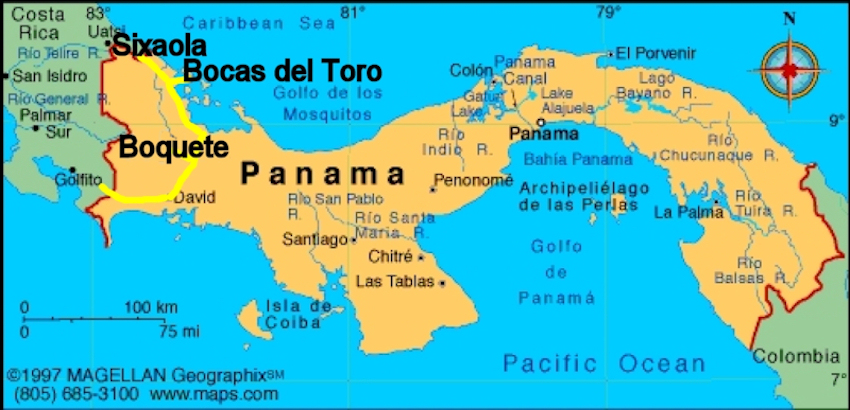Panama

Historie
The Isthmus of Panama was formed about 3 million years ago when the land bridge between North and South America finally
closed, after which plants and animals gradually crossed it in both directions.
The existence of the isthmus had an impact on the dispersal of people, agriculture and technology throughout the American continent
from the appearance of the first hunters and collectors to the era of villages and cities.
The earliest artifacts discovered of indigenous peoples in Panama have included Paleo-Indians projectile points.
Later central Panama was home to some of the first pottery-making in the Americas, such as the Monagrillo cultures dating
to about 2500–1700 BC. These evolved into significant populations that are best known through the spectacular burials (dating to
c. 500–900 AD) at the Monagrillo archaeological site, and the beautiful polychrome pottery of the Gran Coclé style.
The monumental monolithic sculptures at the Barriles (Chiriqui) site are other important evidence of the ancient isthmian
cultures.
Rodrigo de Bastidas, sailing westward from Venezuela in 1501 in search of gold, was the first European to explore the isthmus
of Panama. A year later, Christopher Columbus visited the isthmus and established a short-lived settlement in the
Darien.
Vasco Núñez de Balboa's tortuous trek from the Atlantic to the Pacific in 1513 demonstrated that the Isthmus was, indeed,
the path between the seas, and Panama quickly became the crossroads and marketplace of Spain's empire in the New World. Gold and
silver were brought by ship from South America, hauled across the isthmus, and loaded aboard ships for Spain. The route became
known as the Camino Real, or Royal Road, although it was more commonly known as Camino de Cruces (Road of the
Crosses) because of the abundance of gravesites along the way.
Panama, under Spanish rule for almost 300 years (1538–1821) became part of the Viceroyalty of Peru, along with all other
Spanish possessions in South America.
In the first eighty years following independence from Spain, Panama was a department of Colombia, since voluntarily becoming
part of it at the end of 1821. The people of the isthmus made several attempts to secede and came close to success in 1831, and
again during the Thousand Days' War of 1899–1902. When the Senate of Colombia rejected the Hay–Herrán Treaty
(January 22, 1903), the United States decided to support the Panamanian independence movement.
In November 1903 Panama proclaimed its independence and concluded the Hay–Bunau-Varilla Treaty with the United States. The
treaty granted rights to the United States "as if it were sovereign" in a zone roughly 16 km wide and 80 km long.
In that zone, the U.S. would build a canal, then administer, fortify, and defend it "in perpetuity". In 1914, the United States
completed the existing 83 km canal.
The United States of America's intentions to influence the area (especially the Panama Canal construction and control) led to
the separation of Panama from Colombia in 1903 and the establishment of it as a nation.
From 1903 until 1968, Panama was a constitutional democracy dominated by a commercially oriented oligarchy.
The United States long maintained numerous military bases and a substantial garrison throughout the Canal Zone to protect the
American-owned Panama Canal and to maintain American control of this strategically important area.
On 7 September 1977, President of the United States Jimmy Carter and the de facto leader of Panama, General Omar
Torrijos, signed Torrijos–Carter Treaties, which set in motion the process of handing over the Panama Canal to Panamanian
control by the year 2000.
On December 20, 1989, the United States broke both international law and its own government policies by invading Panama (code-named
Operation Just Cause) in order to bring its President Manuel Noriega to justice for drug trafficking.
The military was able to quickly achieve its goals as Noriega surrendered on January 3, 1990. He was taken to the US, tried,
convicted and jailed on drug trafficking charges and is currently serving his 40-year sentence in Miami.
On September 1, 1999, Mireya Moscoso, took office after defeating PRD candidate Martin Torrijos, in a free and
fair election.
During her administration, Moscoso attempted to strengthen social programs, especially for child and youth development, protection,
and general welfare. Moscoso's administration successfully handled the Panama Canal transfer and was effective in the
administration of the Canal.
I have visited Panama in januari 2005
It was part of my 30 days trip to Central America.
These are the places i have seen
Borderpassing Costa Rica - Panama
Bocas del Toro
Boquete
Please let me know when you're having questions.
i would be pleased to help you.
Things to do and other tips
